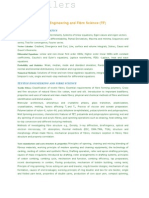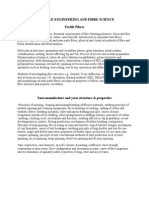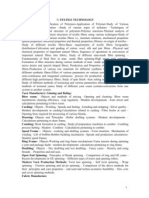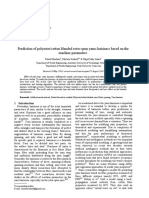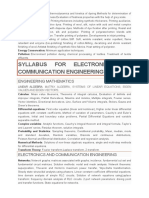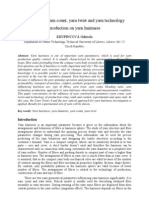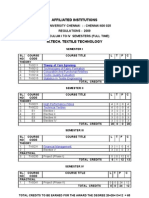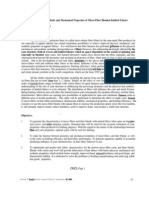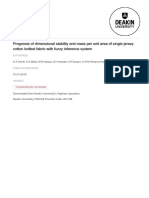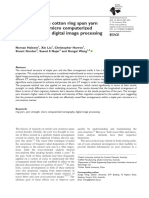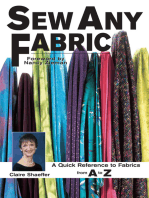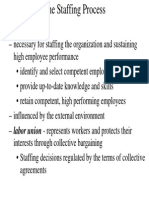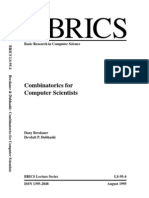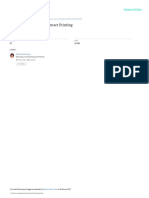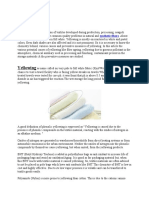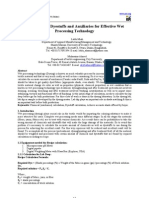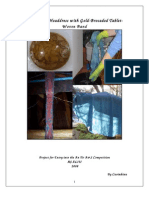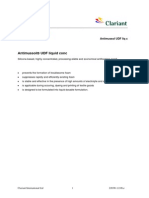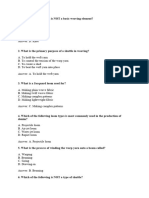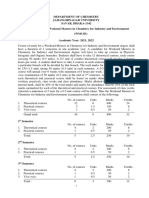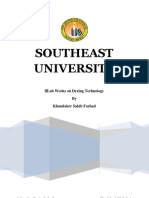Syllabus For Textile Engineering and Fibre Science (TF) : Linear Algebra
Syllabus For Textile Engineering and Fibre Science (TF) : Linear Algebra
Uploaded by
kamalkantmbbsCopyright:
Available Formats
Syllabus For Textile Engineering and Fibre Science (TF) : Linear Algebra
Syllabus For Textile Engineering and Fibre Science (TF) : Linear Algebra
Uploaded by
kamalkantmbbsOriginal Description:
Original Title
Copyright
Available Formats
Share this document
Did you find this document useful?
Is this content inappropriate?
Copyright:
Available Formats
Syllabus For Textile Engineering and Fibre Science (TF) : Linear Algebra
Syllabus For Textile Engineering and Fibre Science (TF) : Linear Algebra
Uploaded by
kamalkantmbbsCopyright:
Available Formats
SYLLABUS FOR TEXTILE ENGINEERING AND FIBRE SCIENCE (TF)
Engineering Mathematics Linear Algebra:
Matrices and Determinants, Systems of linear equations, Eigen values and eigen vectors.
Calculus:
Limit, continuity and differentiability; Partial Derivatives; Maxima and minima; Sequences and series; Test for convergence; Fourier series.
Vector Calculus:
Gradient; Divergence and Curl; Line; surface and volume integrals; Stokes, Gauss and Green's theorems.
Diferential Equations:
Linear and non-linear first order ODEs; Higher order linear ODEs with constant coefficients; Cauchy's and Euler's equations; Laplace transforms; PDEs - Laplace, heat and wave equations.
Probability and Statistics:
Mean, median, mode and standard deviation; Random variables; Poisson, normal and binomial distributions; Correlation and regression analysis.
Numerical Methods:
Solutions of linear and non-linear algebraic equations; integration of trapezoidal and Simpson's rule; single and multi-step methods for differential equations.
Textile Engineering and Fibre Science Textile Fibres:
Classification of textile fibres; Essential requirements of fibre forming polymers; Gross and fine structure of natural fibres like cotton, wool and silk. Introduction to important bast fibres; properties and uses of natural and man-made fibres; physical and chemical methods of fibre and blend identification and blend analysis. Molecular architecture, amorphous and crystalline phases, glass transition, plasticization, crystallization, melting, factors affecting Tg and Tm; Process of viscose and acetate preparation. Polymerization of nylon-6, nylon-66, poly (ethylene terephthalate), polyacrylonitrile and polypropylene; Melt Spinning processes, characteristic features of PET, polyamide and polypropylene spinning; wet and dry spinning of viscose and acrylic fibres; post spinning operations such as drawing, heat setting, tow-to-top conversion and different texturing methods. Methods of investigating fibre structure e.g., Density, X-ray diffraction, birefringence, optical and electron microscopy, I.R. absorption, thermal methods (DSC, DMA/TMA, TGA); structure and morphology of man-made fibres, mechanical properties of fibres, moisture sorption in fibres; fibre structure and property correlation.
Yarn manufacture and yarn structure & properties:
Principles of opening, cleaning and mixing/blending of fibrous materials, working principle of modern opening and cleaning equipments; the technology of carding, carding of cotton and synthetic fibres; Drafting operation, roller and apron drafting principle, causes of mass irregularity introduced by drafting; roller arrangements in drafting systems; principles of cotton combing, combing cycle, mechanism and function, combing efficiency, lap preparation; recent developments in comber; Roving production, mechanism of bobbin building, roving twist; Principle of ring spinning, forces acting on yarn and traveler; ring & traveler designs; mechanism of cop formation, causes of end breakages; working principle of ring doubler and two for one twister, single and folded yarn twist, properties of double yarns, production of core spun yarn, compact spinning, principle of non conventional methods of yarn production such as rotor spinning, air jet spinning, wrap spinning, twist less spinning and friction spinning. Yarn contraction, yarn diameter, specific volume & packing coefficient; twist strength relationship in spun yarns; fibre configuration and orientation in yarn; cause of fibre migration and its estimation, irregularity index, properties of ring, rotor and air-jet yarns.
Fabric manufacture and Fabric Structure:
Principles of cheese and cone winding processes and machines; random and precision winding; package faults and their remedies; yarn clearers and tensioners; different systems of yarn splicing; features of modern cone winding machines; different types of warping creels; features of modern beam and sectional warping machines; different sizing systems, sizing of spun and filament yarns, modern sizing machines; principles of pirn winding processes and machines; primary and secondary motions of loom, effect of their settings and timings on fabric formation, fabric appearance and weaving
performance; dobby and jacquard shedding; mechanics of weft insertion with shuttle; warp and weft stop motions, warp protection, weft replenishment; functional principles of weft insertion systems of shuttle-less weaving machines, principles of multiphase and circular looms. Principles of weft and warp knitting; basic weft and warp knitted structures. Classification, production and areas of application of nonwoven fabrics. Basic woven fabric constructions and their derivatives; crepe, cord, terry, gauze, leno and double cloth constructions. Peirce's equations for fabric geometry; elastica model of plain woven fabrics; thickness, cover and maximum sett of woven fabrics.
Textile Testing:
Sampling techniques, sample size and sampling errors. Measurement of fibre length, fineness, crimp, strength and reflectance; measurement of cotton fibre maturity and trash content; HVI and AFIS for fibre testing. Measurement of yarn count, twist and hairiness; tensile testing of fibres, yarns and fabrics; evenness testing of slivers, rovings and yarns; testing equipment for measurement test methods of fabric properties like thickness, compressibility, air permeability, drape, crease recovery, tear strength, bursting strength and abrasion resistance. FAST and Kawabata instruments and systems for objective fabric evaluation. Statistical data analysis of experimental results. Correlation analysis, significance tests and analysis of variance; frequency distributions and control charts.
Preparatory Processes:
Chemistry and practice of preparatory processes for cotton, wool and silk. Mercerization of cotton. Preparatory processes for nylon, polyester and acrylic and polyester/cotton blends.
Dyeing:
Classification of dyes. Dyeing of cotton, wool, silk, polyester, nylon and acrylic with appropriate dye classes. Dyeing polyester/cotton and polyester/wool blends. Batchwise and continuous dyeing machines. Dyeing of cotton knitted fabrics and machines used. Dye fibre interaction. Introduction to thermodynamics and kinetics of dyeing. Methods for determination of wash, light and rubbing fastness. Evaluation of fastness properties with the help of grey scale.
Printing:
Styles of printing. Printing thickeners including synthetic thickeners. Printing auxiliaries. Printing of cotton with reactive dyes. Printing of wool, silk, nylon with acid and metal complex dyes. Printing of polyester with disperse dyes. Methods of dye fixation after printing. Resist and discharge printing of cotton, silk and polyester. Printing of
polyester/cotton blends with disperse/reactive combination. Transfer printing of polyester. Developments in inkjet printing.
Finishing:
Mechanical finishing of cotton. Stiff. Soft, wrinkle resistant, water repellent, flame retardant and enzyme (bio-polishing) finishing of cotton. Milling, decatizing and shrink resistant finishing of wool. Antistat finishing of synthetic fibre fabrics. Heat setting of polyester.
Energy Conservation:
Minimum application techniques.
Pollution:
Environment pollution during chemical processing of textiles. Treatment of textile effluents.
You might also like
- DyewaDocument4 pagesDyewaaymanNo ratings yet
- Managers Who Make A Difference PDFDocument44 pagesManagers Who Make A Difference PDFkamalkantmbbs100% (3)
- Gate 2014 Syllabus Textile Engineering and Fibre Science TFDocument3 pagesGate 2014 Syllabus Textile Engineering and Fibre Science TFapi-287058159No ratings yet
- GATE Syllabus For Textile Engineering and Fiber ScienceDocument4 pagesGATE Syllabus For Textile Engineering and Fiber ScienceVinay Prajapati100% (1)
- Textile Engineering and Fibre ScienceDocument3 pagesTextile Engineering and Fibre ScienceNikhil TakbhateNo ratings yet
- TF - Gate 2021Document3 pagesTF - Gate 2021ARIHARASUDHAN sNo ratings yet
- GateDocument3 pagesGatesandeepNo ratings yet
- GATE SyllabusDocument3 pagesGATE Syllabusgotita shuklaNo ratings yet
- Textile Engineering mtqp12Document4 pagesTextile Engineering mtqp12Ankit SinghNo ratings yet
- Gate Syllabus For TextileDocument2 pagesGate Syllabus For Textileshubham_yadav51710% (1)
- Introduction To Textile TechnologyDocument2 pagesIntroduction To Textile Technologyabhijeet9solankiNo ratings yet
- Diploma Lect Textile Technology PDFDocument2 pagesDiploma Lect Textile Technology PDFRevappa YeddeNo ratings yet
- GATE SyllabusDocument3 pagesGATE SyllabusMahesh PurbiaNo ratings yet
- Sche SyllDocument5 pagesSche SyllkanjilalsusnataNo ratings yet
- Masters in MMTTDocument3 pagesMasters in MMTTPramod BadbadeNo ratings yet
- 116102005Document4 pages116102005mohan smrNo ratings yet
- Course Outline 1Document2 pagesCourse Outline 1kkkgn007No ratings yet
- I Semester 15Tt01 Quantitative Techniques in Textile Engineering 3 0 0 3Document26 pagesI Semester 15Tt01 Quantitative Techniques in Textile Engineering 3 0 0 3RAGHUL MNo ratings yet
- Textile Engineering 2007Document4 pagesTextile Engineering 2007Shahin MahmudNo ratings yet
- Yarn Clearing SystemsDocument11 pagesYarn Clearing SystemsLohit MohapatraNo ratings yet
- Course ID Course Title Course Hours Class Hours Course DescriptionDocument3 pagesCourse ID Course Title Course Hours Class Hours Course DescriptionProf Dr Md Saifur RahmanNo ratings yet
- SyllabusDocument6 pagesSyllabusHasmukh ShahNo ratings yet
- Prediction of Polyester/cotton Blended Rotor-Spun Yarns Hairiness Based On The Machine ParametersDocument7 pagesPrediction of Polyester/cotton Blended Rotor-Spun Yarns Hairiness Based On The Machine ParametersRavi KumarNo ratings yet
- Modified Btech Tex 5th Semester SyllabusDocument10 pagesModified Btech Tex 5th Semester SyllabusPulak DebnathNo ratings yet
- Measurement of Seam Puckering and Influence of Its Causes: Sandun Fernando Tss JayawardenaDocument7 pagesMeasurement of Seam Puckering and Influence of Its Causes: Sandun Fernando Tss JayawardenaIOSRJEN : hard copy, certificates, Call for Papers 2013, publishing of journalNo ratings yet
- M.SC Fashion DesigningDocument27 pagesM.SC Fashion DesigningAIM INSTITUTENo ratings yet
- Modified Btech Tex 6th Semester SyllabusDocument11 pagesModified Btech Tex 6th Semester SyllabusPulak DebnathNo ratings yet
- Syllabus FOR Electronics AND Communication Engineering (Ec)Document3 pagesSyllabus FOR Electronics AND Communication Engineering (Ec)kldfurio111No ratings yet
- Measurement of Seam Puckering and in Uence of Its Causes: IOSR Journal of Engineering April 2014Document8 pagesMeasurement of Seam Puckering and in Uence of Its Causes: IOSR Journal of Engineering April 2014Trangg BiNo ratings yet
- Full Book TPSPDocument120 pagesFull Book TPSPDeenaNo ratings yet
- PTTDocument17 pagesPTTMark Riha JrNo ratings yet
- Online Control of Knitted Fabric Quality: Loop Length ControlDocument6 pagesOnline Control of Knitted Fabric Quality: Loop Length Controltorsha fahadNo ratings yet
- Lecture 6Document24 pagesLecture 6Muhammad HassanNo ratings yet
- 204Document10 pages204moorthy_sweetyNo ratings yet
- Introduction To WeavingDocument17 pagesIntroduction To WeavingJahaziNo ratings yet
- Hairiness - I PDFDocument4 pagesHairiness - I PDFDurairaj.NNo ratings yet
- M.tech. Textile TechnologyDocument26 pagesM.tech. Textile TechnologyNilesh Shingote100% (1)
- Books On Fibre - Yarn - Fabric - Textile IndustryDocument15 pagesBooks On Fibre - Yarn - Fabric - Textile Industryhaw100% (1)
- Unit IDocument2 pagesUnit IBhuva_janaNo ratings yet
- Ijget - The Influence of - Niromi SeramDocument8 pagesIjget - The Influence of - Niromi Seramiaset123No ratings yet
- Six SigmaDocument6 pagesSix Sigmasayeef khanNo ratings yet
- How To Find Yarn Count From GSM - Textile Learner PDFDocument1 pageHow To Find Yarn Count From GSM - Textile Learner PDFKM NAZRUL Islam0% (1)
- 2 Carding LONGDocument118 pages2 Carding LONGzohaab AhmadNo ratings yet
- Uster Analysis of Cotton/polyester Blended Spun Yarns With Different CountsDocument14 pagesUster Analysis of Cotton/polyester Blended Spun Yarns With Different CountsQuocHuynhNo ratings yet
- Ijftr 36 (3) 227-233Document0 pagesIjftr 36 (3) 227-233M A HasanNo ratings yet
- Explaining TextilesDocument109 pagesExplaining TextilesGOWTHAM CHANDRUNo ratings yet
- Books List On YarnDocument5 pagesBooks List On YarnSohanur Rahman Sobuj100% (1)
- Ftee 63 63Document5 pagesFtee 63 63balachandrankrishnanNo ratings yet
- Raihah 1Document10 pagesRaihah 1asmojekNo ratings yet
- IV B.E. (Textile Technology)Document6 pagesIV B.E. (Textile Technology)9y9aNo ratings yet
- Knitting: Ms. Nasrin AkterDocument24 pagesKnitting: Ms. Nasrin AkterCimaNo ratings yet
- Haque Prognosisofdimensional 2019Document16 pagesHaque Prognosisofdimensional 2019tanveerhusseinNo ratings yet
- Mechanics Review 2Document5 pagesMechanics Review 2eradu seidNo ratings yet
- Es2 KTDocument3 pagesEs2 KTPalash BaruaNo ratings yet
- Effect of Cotton Yarn Imperfection Index On CSPDocument4 pagesEffect of Cotton Yarn Imperfection Index On CSPInternational Journal of Innovative Science and Research TechnologyNo ratings yet
- Abrasion Resistance Property of Woven FabricsDocument3 pagesAbrasion Resistance Property of Woven FabricsJothi Vel Murugan100% (1)
- A Comparative Analysis of Knitting ParametersDocument36 pagesA Comparative Analysis of Knitting ParametersmanojNo ratings yet
- Knits LudhianaDocument25 pagesKnits LudhianaRoha RohaNo ratings yet
- Liu Investigatingthecotton 2019Document17 pagesLiu Investigatingthecotton 2019Khanh NguyenNo ratings yet
- Recent Development in Denim ManufacturingDocument24 pagesRecent Development in Denim ManufacturingMichael LiuNo ratings yet
- The Staffing Process: Labor Union - Represents Workers and Protects TheirDocument28 pagesThe Staffing Process: Labor Union - Represents Workers and Protects TheirkamalkantmbbsNo ratings yet
- Biju Patnaik University of Technology, Orissa Rourkela: Form No.: ACA-01Document13 pagesBiju Patnaik University of Technology, Orissa Rourkela: Form No.: ACA-01abh_sah2No ratings yet
- Combinatorics For Computer ScientistsDocument195 pagesCombinatorics For Computer ScientistskamalkantmbbsNo ratings yet
- M C M C L: ATH Ircles ATH Ircles IbraryDocument22 pagesM C M C L: ATH Ircles ATH Ircles Ibrarykamalkantmbbs100% (1)
- Problem E1. The Magnetic Permeability of Water: (10 Points)Document4 pagesProblem E1. The Magnetic Permeability of Water: (10 Points)kamalkantmbbsNo ratings yet
- Hbcse: Roll Number: P 1 3Document28 pagesHbcse: Roll Number: P 1 3kamalkantmbbsNo ratings yet
- GATE 2012 Answer Key Paper: PH: Paper Question No. Key Paper Question No. KeyDocument1 pageGATE 2012 Answer Key Paper: PH: Paper Question No. Key Paper Question No. KeykamalkantmbbsNo ratings yet
- Bput Mba 07 08 RegularDocument101 pagesBput Mba 07 08 RegularkamalkantmbbsNo ratings yet
- Classification of DyesDocument60 pagesClassification of DyesAnkurVaidyaNo ratings yet
- PATTERNSFROMNATUREDocument12 pagesPATTERNSFROMNATURElitaNo ratings yet
- Albatex: AR Reduction InhibitorDocument4 pagesAlbatex: AR Reduction Inhibitorsasko100% (1)
- Test 3 (IELTS Master Reading)Document6 pagesTest 3 (IELTS Master Reading)Lincoln PattonNo ratings yet
- Abstract:: Phenolic YellowingDocument8 pagesAbstract:: Phenolic YellowingMd.oaliur RahamanNo ratings yet
- Calculation of Dyestuffs and Auxiliaries For Effective Wet Processing TechnologyDocument3 pagesCalculation of Dyestuffs and Auxiliaries For Effective Wet Processing TechnologyAlexander DeckerNo ratings yet
- Problem Solving - KnitsDocument17 pagesProblem Solving - KnitsBhaskar Mitra100% (1)
- Textile Printing and AdvancementsDocument8 pagesTextile Printing and AdvancementsShahan AkhtarNo ratings yet
- Apu 1.Document3 pagesApu 1.Md Golam KibriaNo ratings yet
- Trading Painting and PaintersDocument171 pagesTrading Painting and PaintersEllean PaloNo ratings yet
- 5 Best Available TechniquesDocument13 pages5 Best Available TechniquesAssada SangnapapeanNo ratings yet
- Removal of Dyes From Textile Industry Effluent: A ReviewDocument5 pagesRemoval of Dyes From Textile Industry Effluent: A ReviewBinu GeorgeNo ratings yet
- Dictionary of Terms Used in The Hides, Skins, and Leather TradeDocument69 pagesDictionary of Terms Used in The Hides, Skins, and Leather TradePablo DíazNo ratings yet
- Viking AgeHeaddresswTabletWovenBandDocument28 pagesViking AgeHeaddresswTabletWovenBandKatarzyna-Katla Czylok100% (2)
- Textile Vision - Fayyaz Industry Support CellDocument596 pagesTextile Vision - Fayyaz Industry Support CellTaimur Shan100% (1)
- Antimussol UDF Liq C - e PDFDocument3 pagesAntimussol UDF Liq C - e PDFAnonymous N0eiVk1SNo ratings yet
- PERIPRET PW NEW TDS enDocument2 pagesPERIPRET PW NEW TDS enirc.indusNo ratings yet
- Dye Fixing AgentDocument2 pagesDye Fixing AgentSachin Patil100% (2)
- Tie Dye: Author: Rachel Morgan TheallDocument7 pagesTie Dye: Author: Rachel Morgan Theallsandeep303797No ratings yet
- 101 Mcqs On Textile ScienceDocument19 pages101 Mcqs On Textile Sciencesandip kumar mishra100% (1)
- Lnci Technical Information: Altranol-NoviDocument4 pagesLnci Technical Information: Altranol-Novithe griffendorsNo ratings yet
- Albatex DBS 200812Document3 pagesAlbatex DBS 200812RickgableNo ratings yet
- Piyush - Pigment Printing Process 03Document26 pagesPiyush - Pigment Printing Process 03Shweta Iyer100% (3)
- JamesHeal TestMaterials 24ppDocument13 pagesJamesHeal TestMaterials 24pp郭哲宏No ratings yet
- Chapter-2: Growth and Prospects of Chemical Industry in GujaratDocument57 pagesChapter-2: Growth and Prospects of Chemical Industry in GujaratbecbellaryNo ratings yet
- Improving The RemovalDocument19 pagesImproving The RemovalFathi MustafaNo ratings yet
- WMCIE JU Syllabus 2021 2022Document26 pagesWMCIE JU Syllabus 2021 2022Rajesh RoyNo ratings yet
- Textile Dyeing Document For Lab Matching With Various Dyes. (Exhaust Process)Document89 pagesTextile Dyeing Document For Lab Matching With Various Dyes. (Exhaust Process)Khandaker Sakib Farhad100% (1)
- Introduction To Textiles 2Document102 pagesIntroduction To Textiles 2Md NurunnabiNo ratings yet


